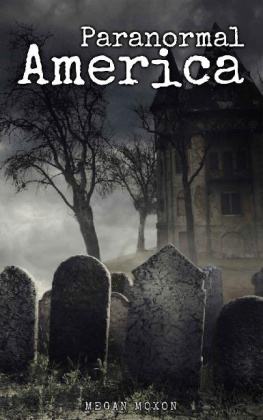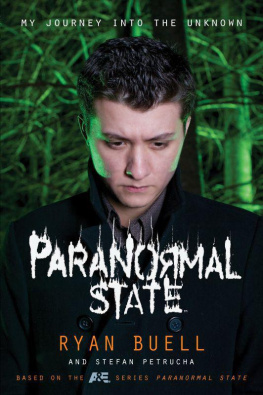For Randi and Joe, the best of the best.
Copyright 2010 by Benjamin Radford All rights reserved
Publisher Cataloging-in-Publication Data
Radford, Benjamin.
Scientific Paranormal Investigation: how to solve unexplained mysteries / by Benjamin Radford
p. cm
Includes bibliographical references and index. ISBN 978-0-936455-11-2
1. Curiosities and wonders. 2. Forensic sciences-- Miscellanea. 3. Parapsychology. I. Title.
BF1031.R33 2010
133-dc21
Printed in the United States of America
Edited by Lisa Jong-Soon Goodlin
Cover by Marty Blake Graphic Design
Book design by Christopher Fix
Rhombus Publishing Company P.O. Box 806
Corrales NM 87048 USA
www.RhombusBooks.com
Acknowledgements
This book would not have been possible without the support of many people. In addition to those mentioned in the text, I am grateful to many friends and colleagues for inspiration and assistance, including Robert Bartholomew, Tim Binga, Ed and Diane Buckner, Kevin Christopher, Christopher Fix, Kendrick Frazier, Martin Gardner, Jenna Griffith, Ray Hyman, Tom Flynn, Lisa Goodlin, DJ Grothe, Barry Karr, Paul Kurtz, Scott Lilienfeld, Daniel Loxton, Paul Loynes, Joe Nickell, Massimo Polidoro, James Randi, Carl Sagan, Blake Smith, Jim Underdown, Richard Wiseman, and others. The late Barry Beyerstein and Michael Dennett were excellent researchers and good colleagues, and are sorely missed.
Rob Britt, my editor at LiveScience.com, supported my efforts to bring science and skepticism to the public (and stood by me through quasi-threats of lawsuits from disgruntled psychics and New York Times reporters). Thanks also to my friends and family through the years who accepted the fact that any trip to another country with me would likely be spent at least partly investigating local ghosts, monsters, and miracles.
Table of Contents
Chapter 4: How Not to Investigate the Paranormal:
Science and Pseudoscience in Ghost Investigations
Introduction
To kill an error is as good a service as, and sometimes even better than, the establishing of a new truth or fact.
- Charles Darwin
Scientific Paranormal Investigation is designed to be useful to a variety of people with different interests. First, for would-be paranormal investigators, those who have read about the worlds strange mysteries and want to try their hand at it, this is a how to guide for conducting successful scientific investigations into unexplained phenomenon. Interest in the paranormal has rarely been higher; top-rated TV shows feed the publics interest in the supernatural. Millions of people watch paranormal-themed television shows on everything from ghosts to psychic detectives, monsters to crop circles, not realizing that they are seeing entertainment instead of actual investigation. (For a scientific analysis of the ghost hunting on such shows, , How Not to Investigate the Paranormal: Science and Pseudoscience in Ghost Investigations.) Reading this book wont make you a scientific paranormal investigator, any more than reading a book on car repair makes you a mechanic. But it will give you insight into the process and a solid blueprint to work from.
For people with some knowledge of skepticism and an interest in the paranormalbut who dont necessarily have the time, inclination, or ability to become a paranormal investigator themselvesthe collection of illustrative case studies in this book will provide important background information on the topics. Being knowledgeable about solved cases can be very useful when discussing paranormal topics with skeptics and believers alike.
For the millions who have an interest in the paranormal but who are not necessarily familiar with what skeptics are or what they do, this book provides an understanding of skepticism and how science can be applied to modern mysteries and the paranormal. People are often surprised to learn that paranormal phenomena can beand indeed has beensubjected to solid scientific analysis. Understanding skepticism will make you a better critical thinker. The principles of skepticism and scientific investigation are identical and apply far beyond exotic topics like ghosts and monsters; they will help you spot logical fallacies and faulty arguments in all areas. The information and case studies here will give the other side of the story all too often missing from mystery-mongering, pro-paranormal books, shows, and magazine articles on the topics.
Many readers with no particular interest in investigation will find firsthand accounts of a wide variety of fascinating topics: psychic cats, bloodthirsty lake monsters, cruel voodoo witches, ghosts, ESP tests, and much more. Anyone with an interest in the bizarre and unexplained will find a treasure trove of mysteriesall examined from a credible, scientific point of view.
This book focuses on the practical aspects of applied skepticism. I have resisted the temptation to delve too deeply into the philosophy and history of skepticism. Its important to understand the nature, scope, and context of skeptical investigation, but others have done a far superior job in discussing these matters than I could. There are wonderful books by the great philosophers of skepticism, from David Hume to Paul Kurtz, and those works appear in the extensive bibliography. I encourage interested readers to seek out the sources and references I provide, as well as the books in the recommended further reading sections. Joe Nickells books, especially Missing Pieces: How to Investigate Ghosts, UFOs, Psychics, and Other Mysteries , are other excellent resources.
I have been involved in hundreds of investigations over the years. Some cases were solved in a few hours by consulting references; others took months of research and preparation. A thorough background in science is helpful, but not necessary to be a knowledgeable skeptic. Many of the keys to understanding skepticism are accessible to the average person. These principles include understanding the basics of chance and randomness; understanding scientific methods; an appreciation of psychology (including how beliefs are formed, and how we fool others and ourselves); and the principles of critical thinking (Occams razor, logical fallacies, etc.). Many of the so-called soft sciences, such as linguistics and sociology, have made important contributions to skepticism. I can speak knowledgeably about skepticism, science, and many aspects of the paranormal, but Im not a professional scientist. I do, however, have a solid understanding of how science works, and what makes good and bad science.
Throughout this book I share personal anecdotes. This is inevitable, as my skepticism is an ingrained characteristic, a guide for living. It is not simply a set of principles I pull out of a bag when it comes time to play Sherlock Holmes or Fox Mulder. Investigation is a personal enterprise, and trying to separate out the personal from the professional is not only pointless but counterproductive. (One of the most popular and powerful columns in Skeptical Inquirer Magazine that Joe Nickell ever wrote was a personal story about intuition, and how it united him with a long-lost daughter.)
In some ways anecdotes are a bane of investigators, for they are not evidence. In this book the anecdotes are offered not as evidence but as examples. Personal, concrete examples illustrating a principle are much more easily learned and remembered than generic guidelines, so I hope the reader will pardon any digressions.
There are thousands of people in the world who call themselves paranormal investigators, ghost hunters, or something similar. Paranormal investigation requires no certificate; anyone can do it with no training, knowledge, or expertise whatsoever. Whether they are effective or not actually solve any mysteriesis another matter entirely.













